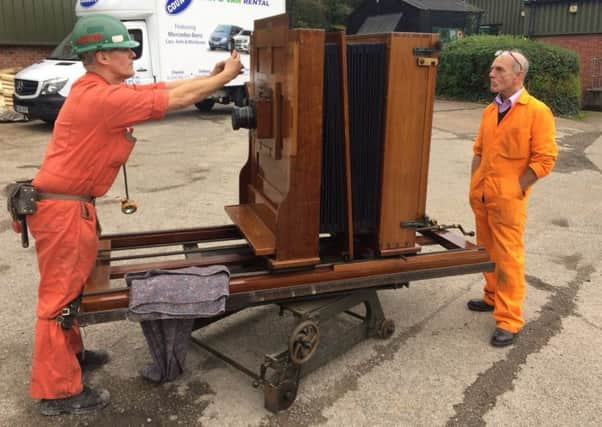The past in focus at Wakefield's Mining Museum


It was while rooting around a storage room that Ian Beesley stumbled across the inspiration for his latest project – a giant camera, 8ft long and 5ft high, one that takes four people to move and which was built to use film that isn’t made anymore. “One day when I was artist in residence at Gallery Oldham I was mooching around their archives and underneath a big sheet I found this absolutely massive camera,” says the Bradford-based photographer.
“It had once been part of the displays, but had been removed some years earlier. So the story goes, one night the security guard heard what sounded like a break-in.
Advertisement
Hide AdAdvertisement
Hide Ad“They couldn’t find anyone, but eventually they heard a knocking. It was coming from the back of the camera – it turned out the burglar had hidden inside and then couldn’t get out. Now a camera, big enough to fit a human in, that got me intrigued.”
Years of sitting idle had taken its toll on the camera and it took Beesley a few months to restore the various mechanisms to working order. That, however, turned out to be the easy bit.
“It had been originally built 100 years ago to copy wallpaper patterns,” he says. “It used 24ins film which just isn’t made anymore, so instead I had to load four different reels of film. Everything with this camera requires times and patience and when I first started out I was averaging one picture a day.”
Things have speeded up a little, but it still remains a slow process compared to the instantaneous images offered by digital cameras.
Advertisement
Hide AdAdvertisement
Hide Ad“It doesn’t have a shutter, so that means you have to use a very long exposure,” adds Beesley. “For portraits you have to ask the sitter to remain still for 30 seconds. That might seem like no time at all, but when you are in front of a giant camera it can seem like forever.
“It is also possible to spoil the final image with light at almost any point. I had to tell people, ‘This is going to take a long time and there is no guarantee that there will be a usable print in the end’.”
All of which begs the question, why bother?
“What I really like about it is that it’s going back to the original days of photography when it was a really physical process and once I’d mastered taking the pictures I really wanted to do a collection of portraits.”
Having previously done some work capturing the end of Kellingley Colliery, Ian approached the National Coal Mining Museum, where a number of ex-miners work, to see if they wanted to be part of the project.
Advertisement
Hide AdAdvertisement
Hide AdThey did and the images, which show the negative alongside the final portrait, will go on display at the museum next week.
“It’s funny, but those growing up now have never seen a negative. It’s a completely alien concept. That was one reason why I wanted to display them together, but there was another.
“When I showed one of the negative images to one of the ex-miners he said, ‘That looks like the ghost of my profession’.
“It’s true. Also when you take a picture of someone wearing contemporary dress, but using a Victorian technique it does lend a historic quality to the image that felt fitting for this collection.”
The Big Big Camera, National Coal Mining Museum, Wakefield, January 24 to February 28. For details visit www.ncm.org.uk